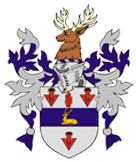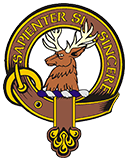Battles of Invernhaven And Perth – 1300s
Finally, as a garnish, there is something more to discuss about names and naming conventions. Let us return to our Mr. Gow, hero of the battle to see what further aid he can give us. Most of you will know that a “sept” or associated name can come from a number of places: a derivation of a spelling, a patrilineal etymology, or from an association of a smaller clan or family with one larger, the latter offering protection or otherwise mutually beneficial arrangements. There is no fully reliable source to indicate that sept names were in use inside the larger context of clan and family in 1396, however. It was more common at that time for a “sept” family to take on the name of the protecting or governing chief or the name of a directly related family. Nevertheless, there are a couple of references that suggest the names “Gow” and “Smith” were not names associated with Clan Chattan or Clan MacIntosh prior to the confrontation at the North Inch, yet became “sept” names of the clans thereafter. So, we have we have further evidence to suggest the Chattan presence. What’s more, it would seem that Scott got at least the participation of “Hal o’ the Wynds” right! While this does not suggest we were not Chattan’s opponents, it does give credence to Chattan’s involvement and, given the reasoning against our participation as a clan we have discussed, supports the Chattan versus Cameron position, and refutes the Davidson versus…well, anybody…claims that have tarnished our name for so long. So, in short, we must accept Allison’s narrative and our own deductions as sound.
Moving Forward
Now, as suggested from the outset, having considered all of the above you might reason that perhaps this is just another variation of the story, that it is rife with the same speculative air as the others, or is just another layer added to the pile of uncertainty we have already seen. Perhaps there are elements that still seem unanswered or, at least, are not answered with the absolute certainty we’d all like to have. Here I must apologize: as an archaeologist and an historian, there is never anything truly definitive to give as proof to an audience unless it is by an account from someone dragged forward from the past. So, as with all things in the realm of history, there can be room for doubt even if we have written record.
But, it is also here where I refer you to the tactics laid out in our dialogue. Put all of the information in front of you, and let things overlap. With some logic and deductive reasoning, we see almost instantly that square pegs are trying to fit into round holes if you try to accept the previous “facts.” Additionally, if we take Allison, NTS, and the fruits of other academic labors seriously, a timeline and a narrower fact margin are laid out for us that constrain the data to only those that make sense. We can dismiss everything that doesn’t fit into the correct parameters, which, as I have hopefully shown and has been understood, is the majority of the chaff presented in all of the predominant tales – whichever versions they may be. As the ‘Great Detective’ said, “If we eliminate the impossible (in this case the largest portion of what we “knew”), what remains, however improbable (let’s view “improbable” as those things we can still call speculation, albeit logically reasoned), must be the truth.” Scott’s tale, then, while containing elements of fact, is a more-or-less empty cornerstone on which to build and in which to trust. True, it is entertaining and certainly of great craftsmanship, but as the grandfather of all variants of the Davidson account to date, we should recognize a story, and not necessarily history.
Today, groups of people still meet to do battle at the North Inch, though there are different tactics and fewer casualties (well, sometimes). It is now a soccer pitch, which, as our own Rob Diehl reports, is easily reached with a short walk from the Perth Railway Station. Its lush green turf and pleasant river vistas serve to disguise the fact that a much less affable type of match once took place there. [photo insert: River Tay]
A stone memorial and an interpretive sign are now all that betray its earlier and more sinister use. However, my kith and kin, let’s take heart that we now have ample reason to believe that this site should not hold the same mournful, even shameful, feelings as it may have for us once. Let us remember and honor those who fell at the North Inch, but let us do so with a sense of pride, understanding that we seem to have walked off that field in the troop of victors, and not the victims. [photo inserts: sign and memorial]

